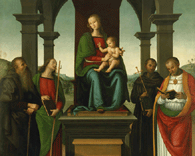
« PREVIOUS ENTRY
Can you kill JFK? My latest Slate gaming column
NEXT ENTRY »
“Teacher, what did Edgar Hoover wear to work?”

That painting above, of the Madonna and child? Art experts have always suspected that Italian Renaissance master Pietro Perugino didn’t paint it entirely by himself. But they were never entirely sure.
Now a team of Dartmouth professors say they’ve mathematically proved that several different people worked on the painting. They developed a technique in which they digitize the painting into a huge 16,852-by-18,204-pixel photo. Then they took the faces of the six people in the painting, and broke them into several hundred sections, 256 by 256 pixels in size. Then, as Wired News reports:
The filtered images were then run through a series of algorithms, the results of which produced a set of numbers. The more similar the painting style, the closer together those numbers were. Once those numbers were plotted on a graph, the Dartmouth team found that points representing the faces on Madonna and two of the saints were crowded together tightly. Baby Jesus and the two other saints — those three were far, far apart. So the researchers believe that one artist painted Madonna and one canonized pair, while three other artists composed the remaining faces.
Art scholars are dubious that the technique is useful, but personally, I’m intrigued by it. It seems like an interesting literalization of the brain’s statistical data-processing equipment. We humans are incredibly good at knowing when faces just don’t quite match up or don’t seem quite right. Though the scientists have picked a bunch of obviously arbitrary mathematical markers, the idea of data that doesn’t “match up” seems like a neat metaphor or analogue for what the brains of art experts are doing when they look at the paintings: They’re crunching the patterns, comparing them to the enormous database of all art they’ve seen before, and detecting something — oh so subtle — amiss.
(Thanks to Noah Shachtman for this one!)
I'm Clive Thompson, the author of Smarter Than You Think: How Technology is Changing Our Minds for the Better (Penguin Press). You can order the book now at Amazon, Barnes and Noble, Powells, Indiebound, or through your local bookstore! I'm also a contributing writer for the New York Times Magazine and a columnist for Wired magazine. Email is here or ping me via the antiquated form of AOL IM (pomeranian99).

ECHO
Erik Weissengruber
Vespaboy
Terri Senft
Tom Igoe
El Rey Del Art
Morgan Noel
Maura Johnston
Cori Eckert
Heather Gold
Andrew Hearst
Chris Allbritton
Bret Dawson
Michele Tepper
Sharyn November
Gail Jaitin
Barnaby Marshall
Frankly, I'd Rather Not
The Shifted Librarian
Ryan Bigge
Nick Denton
Howard Sherman's Nuggets
Serial Deviant
Ellen McDermott
Jeff Liu
Marc Kelsey
Chris Shieh
Iron Monkey
Diversions
Rob Toole
Donut Rock City
Ross Judson
Idle Words
J-Walk Blog
The Antic Muse
Tribblescape
Little Things
Jeff Heer
Abstract Dynamics
Snark Market
Plastic Bag
Sensory Impact
Incoming Signals
MemeFirst
MemoryCard
Majikthise
Ludonauts
Boing Boing
Slashdot
Atrios
Smart Mobs
Plastic
Ludology.org
The Feature
Gizmodo
game girl
Mindjack
Techdirt Wireless News
Corante Gaming blog
Corante Social Software blog
ECHO
SciTech Daily
Arts and Letters Daily
Textually.org
BlogPulse
Robots.net
Alan Reiter's Wireless Data Weblog
Brad DeLong
Viral Marketing Blog
Gameblogs
Slashdot Games